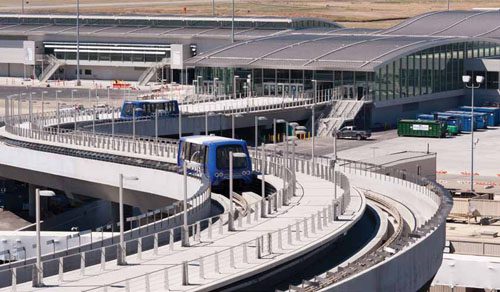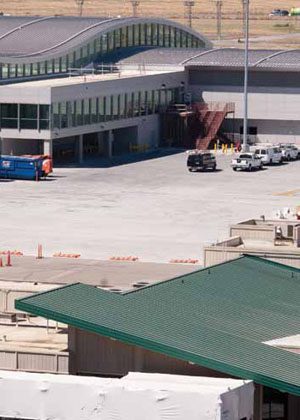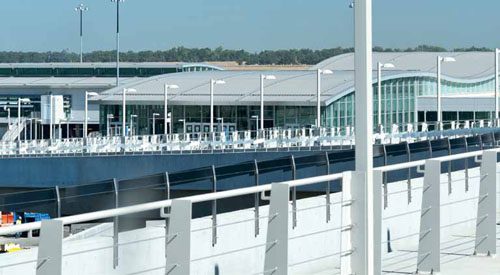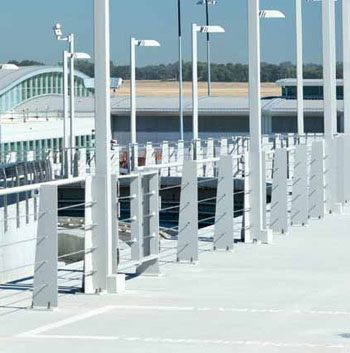
Sacramento International Airport (SMF) wanted a showcase system to transport people between its new landside terminal and airside concourse, and it got exactly that.
|
factsfigures Project: Automated People Mover Location: Sacramento Int’l Airport APM Cost: $29 million Guideway Cost: $13.1 million Capacity: 2,760 people/hour/direction Average Speed: 22 mph Guideway Length: 1,200 ft. Designer of Record: Corgan Associates, with Hatch Mott MacDonald APM Design/Engineering Consultant: Lea+Elliott Guideway Design/Engineering Consultant: Hatch Mott MacDonald APM Design/Manufacturer: Bombardier Transportation (Holdings) USA Contractors: Turner Construction; Flatiron West; Austin-Walsh Construction Communication Facilitator: Aviation Innovation Of Note: An S curve & 5% downhill grade over a relatively short distance challenged guideway designers. |
Initially, the airport purchased only two cars for its Bombardier INNOVIA APM 100, but it can add more for increased capacity.
“We designed the system for future expansion,” explains Leonard Takayama, the airport’s deputy director of special projects. “If we add more gates in the future and have a higher peak demand, the system will accommodate four vehicles. We can purchase another vehicle for each track. As it stands now, if one vehicle goes out of service, the remaining vehicle will operate to meet our current peak demands.”
Based on demand, the system operates in one of its three standard modes. For 16 hours a day, between 6 a.m. and 10 p.m., both cars operate in a synchronized fashion – simultaneously departing from opposite stations and crossing in the approximate center of the guideway system; switching places every 90 seconds.
From 10 p.m. to 1 a.m. and 5 to 6 a.m. (when demand drops), the cars transition to single shuttle mode: One of the two lanes is shut down, and a single vehicle shuttles back and forth automatically.
Between 11 p.m. and 5 a.m. (when demand is at its lowest), the system shifts to on-call mode. One track is taken out of service for inspection and maintenance, while the car on the in-service track remains parked at the airside location and operates on an as-needed basis. Arriving passengers push a button that triggers the doors to open and initiates operation. For passengers traveling from the landside terminal during on-call hours, a designated airport security official uses a card swipe device to summon the train from its airside position.
Bombardier, which has a five-year contract to operate and maintain the system, follows a strict daily inspection and maintenance regimen, notes Bombardier site manager Brad Bonn. Each track is shut down every other night during the on-call hours, and crews perform inspections and preventive maintenance on both the vehicle and track, he explains.
“We have a staff of 12 people who operate and maintain the APM 24/7,” Bonn relates.
Built to Grow
Corgan Associates, designer of record for the airport’s overall terminal construction program, began working with engineering consultant Lea+Elliott in 2008 to procure the APM.
“The selection process was interesting,” recalls Takayama. “At the time we were evaluating proposals, the value of the dollar in comparison to other currencies put the overseas firms at a disadvantage. Their costs were much higher in comparison with Bombardier’s APM division, which is headquartered in Pittsburgh.”
proposals, the value of the dollar in comparison to other currencies put the overseas firms at a disadvantage. Their costs were much higher in comparison with Bombardier’s APM division, which is headquartered in Pittsburgh.”
The design criteria required the APM to be able to move 12 million passengers per year, with the capacity to grow to 16 million passengers a year, recalls Brent Kelley, principal with Corgan Associates.
“Construction was a dual process,” Kelley explains. “We purchased the APM system in late 2008 so that Bombardier would have enough time to complete the system design, construct the cars and deliver them onsite.” At the same time, Turner Construction, in a line-item joint venture with Flatiron West, began construction of the elevated, cast-in-place concrete guideway structure. The 1,200-foot guideway slopes from 44 feet above grade at the terminal building to just 14 feet above grade where it joins the concourse building.
 Bonn considers the guideway superstructure to be the most technically challenging part of the project. “The guideway run is relatively short,” he explains. “But within that 1,200-foot run, there is an S curve and a consistent 5% downhill grade running from landside to airside. From a design standpoint, the geometry of the S curve makes it a very complex challenge to construct a concrete, steel and ironworks structure sloping downhill for such a relatively short distance.”
Bonn considers the guideway superstructure to be the most technically challenging part of the project. “The guideway run is relatively short,” he explains. “But within that 1,200-foot run, there is an S curve and a consistent 5% downhill grade running from landside to airside. From a design standpoint, the geometry of the S curve makes it a very complex challenge to construct a concrete, steel and ironworks structure sloping downhill for such a relatively short distance.”
The guideway structure required a “very unique design,” says Roger Giles, project manager for Flatiron West. “It’s really two different types of bridges,” he notes. Two frames are flat slab construction, and one frame is the more traditional box girder construction. On the flat slab frames, he explains, the emergency walkway was built independent of the guideway structure. On the other frame, it was built on top of the box girder.
more traditional box girder construction. On the flat slab frames, he explains, the emergency walkway was built independent of the guideway structure. On the other frame, it was built on top of the box girder.
“It was certainly a different twist on a traditional form of bridge construction,” Giles concludes.
Timing the procurement of the APM system in relation to initial construction of the guideway proved to be somewhat tricky, recalls Kelley. To stay on schedule, crews began construction of the guideway slightly before the procurement of the APM system was finalized. “We attempted to make t he guideway design as generic as possible,” recalls Kelley, “but we did have to go back and do some finessing to make it fit the Bombardier system.”
he guideway design as generic as possible,” recalls Kelley, “but we did have to go back and do some finessing to make it fit the Bombardier system.”
The guideway’s change in elevation over a relatively short distance made the vertical transition challenging, he relates. “We worked closely with Bombardier to evaluate speeds and guideway construction to accommodate the car’s turn while sloping downward,” he explains. “To make this adjustment and for ride comfort, the guideway was constructed so the car tilts slightly as it moves around the super-elevated curve.”
Committed to Communication
With a project as large and complicated as construction of a new APM, communication among designers, contractors, vendors, tenants and the airport was critical. Airport officials identified its importance from the beginning and put procedures in place to facilitate open and ongoing communication among the significant players.
“Coordination and communication were critical to the success of this project,” says Jenny Baumgartner, project manager for Lea+Elliott. “There were so many different details that could have been easily overlooked, so it was important that everyone talked to the people they needed to talk with, that there were no bottlenecks, that everyone got the information they needed and that the performance specifications were met per the contract. The fact that the project was completed a month early and within budget is testament to everyone working hard and working together.”

Bombardier project director Glenn Morgan attributes the excellent communications and project coordination to the skills and commitment of a very knowledgeable and experienced owner.
 “It all started with them (airport management),” Morgan relates. “They provided a lot of guidance and leadership by keeping to a common goal and target, and motivating everyone to succeed. This is probably the smoothest airport opening I’ve been involved with in 30 years.”
“It all started with them (airport management),” Morgan relates. “They provided a lot of guidance and leadership by keeping to a common goal and target, and motivating everyone to succeed. This is probably the smoothest airport opening I’ve been involved with in 30 years.”
Bonn agrees: “I’ve never been involved in a project with more entities in play and with each of those entities so passionately wanting to succeed for the owner.”
From the beginning, design workshops were held every six to eight weeks to provide participants with a week of focused troubleshooting regarding the design and construction process. With different contractors responsible for the terminal and concourse buildings, and a complex guideway superstructure being constructed to the design specifications of the APM vendor, airport management understood that regular face-to-face meetings were critical.
SMF even hired a professional communications facilitator from Aviation Innovation to help team members identify problems and arrive at solutions. Sometimes the facilitator worked exclusively with the contractors; other times designers and program managers joined in. Tenants participated in yet other meetings.
team members identify problems and arrive at solutions. Sometimes the facilitator worked exclusively with the contractors; other times designers and program managers joined in. Tenants participated in yet other meetings.
To help staff members become comfortable with the APM system, the airport sent operations and maintenance personnel to Bombardier’s assembly plant to see firsthand how the vehicles are constructed.
 “You can’t walk away without being impressed by Bombardier employees,” Takayama says. “From the mechanics putting vehicles together to electricians laying wires, they were all able to answer questions and communicate what they were doing. It helped our staff gain trust in the APM system they would eventually be working with.”
“You can’t walk away without being impressed by Bombardier employees,” Takayama says. “From the mechanics putting vehicles together to electricians laying wires, they were all able to answer questions and communicate what they were doing. It helped our staff gain trust in the APM system they would eventually be working with.”
That trust is earned, he adds. While Bombardier’s contract required the APM system to achieve 98.5% availability for 30 consecutive days during testing, it achieved 99.5% reliability in the first 30 consecutive days.


